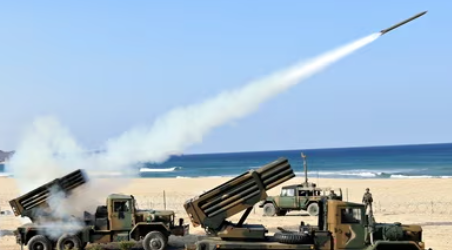North Korea Fires Missiles Amid US-South Korea Drills
The military of South Korea reported that North Korea fired off two ballistic missiles. This happened just one day after North Korea said it would react “offensively and overwhelmingly” to a new military exercise led by the US that included South Korea and Japan.
Details of the Missile Launch
Ten minutes apart, the missiles were fired from Jangyon, a town in the southeast of North Korea. The first missile flew about 370 miles and landed in the water near the city of Chongjin in eastern North Korea. The second missile, on the other hand, flew much shorter, only 120 kilometers (75 miles). It is thought to have crashed in North Korea’s interior, though the exact damage was not immediately clear.
Background and International Response
Soon after the “Freedom Edge” military drills between the US, South Korea, and Japan ended, the missile tests took place. The goal of these drills was to improve joint operations in air and naval warfare and to strengthen defenses against ballistic missile threats. This was done as worries about North Korea’s nuclear capabilities and China’s assertiveness in the area grew.
North Korea’s Position and Strategic Intentions
The Foreign Ministry of North Korea condemned the drills and compared the relationship between the US, South Korea, and Japan to an “Asian version of NATO.” These drills are seen as direct threats to North Korea’s sovereignty and the safety of the area by North Korea. The fact that they responded with missile tests is seen as proof that they are ready to use strong military measures to protect their country’s interests. North Korea and Russia just signed an official defense pact that promises to help each other defend themselves. This shows that North Korea’s military moves are becoming more daring.
More About North Korea-South Korea relations
- Establishment and Division: North Korea and South Korea were formally established as separate states in 1948 following the end of Japanese occupation. The Korean War (1950-1953) further deepened their divide, resulting in separate regimes without a peace treaty, leaving only an armistice in place.
- Moments of Thaw and Cooperation: Relations have seen rare moments of thaw, such as the 2000 and 2007 summits, and symbolic gestures like jointly marching under a unified flag at multiple Olympics. The Kaesong Industrial Complex, initiated in 2004, stands as a rare example of economic cooperation between the two Koreas.
- Ongoing Tensions and the DMZ: Even though there is some communication, events like the sinking of a South Korean warship in 2010 and the shelling of Yeonpyeong Island keep emotions high. The Demilitarized Zone (DMZ), which is highly fortified with guard posts and landmines, is a stark reminder of the ongoing stalemate.
Month: Current Affairs - July, 2024
Category: Defence Current Affairs


